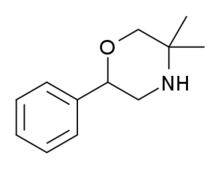G-130
 | |
| Legal status | |
|---|---|
| Legal status |
|
| Identifiers | |
| |
| CAS Number | |
| PubChem CID | |
| ChemSpider | |
| UNII | |
| CompTox Dashboard (EPA) | |
| Chemical and physical data | |
| Formula | C12H17NO |
| Molar mass | 191.274 g·mol−1 |
| 3D model (JSmol) | |
SMILES
| |
InChI
| |
G-130 (GP-130, 2-Phenyl-5,5-dimethyltetrahydro-1,4-oxazine)[1] is a drug with stimulant and anorectic effects, related to phenmetrazine.[2][3][4]
Structural analogs[]
Compounds related to G-130 and radafaxine were synthesized that behave as combined inhibitors of monoamine uptake and nicotinic acetylcholine receptors.[5]
See also[]
- 2-Phenyl-3,6-dimethylmorpholine
- 3-Fluorophenmetrazine
- 4-Methylphenmetrazine
- Phendimetrazine
- Manifaxine
References[]
- ^ GB 1336732, "Diethanolamine derivatives", published 1973-11-07, assigned to Instituto Gentili SPA
- ^ Fanelli O (June 1973). "Pharmacological and toxicological study of a new psychotropic stimulant: the 2-phenyl-5-dimethyl-tetrahydro-1,4-oxazine, in comparison with d,l-amphetamine, phenmetrazine and pemoline-Mg". Arzneimittel-Forschung. 23 (6): 810–6. PMID 4740767.
- ^ Fanelli O, Mazzoncini V, Ferri S (October 1974). "Toxicological and teratological study of 2-phenyl-5,5-dimethyl-tetrahydro-1,4-oxazine hydrochloride (G 130), a psychostimulant drug". Arzneimittel-Forschung. 24 (10): 1627–32. PMID 4479774.
- ^ Fanelli O, Mazzoncini V, Trallori L (December 1974). "Antagonism of psychostimulant 2-phenyl-5,5-dimethyl-tetrahydro-1,4-oxazine hydrochloride (G 130) to central nervous system depressing drugs. Monoamine oxidase inhibitory activity and norepinephrine and serotonin induced changes. Comparison with dL-amphetamine". Arzneimittel-Forschung. 24 (12): 2025–9. PMID 4480283.
- ^ Carroll, F. I.; Muresan, A. Z.; Blough, B. E.; Navarro, H. N. A.; Mascarella, S. W.; Eaton, J. B.; Huang, X.; Damaj, M. I.; Lukas, R. J. (2011). "Synthesis of 2-(Substituted Phenyl)-3,5,5-trimethylmorpholine Analogues and Their Effects on Monoamine Uptake, Nicotinic Acetylcholine Receptor Function, and Behavioral Effects of Nicotine". Journal of Medicinal Chemistry. 54 (5): 1441–1448. doi:10.1021/jm1014555. PMC 3048909. PMID 21319801.
Categories:
- Stimulants
- Phenylmorpholines
- Designer drugs
- Nervous system drug stubs